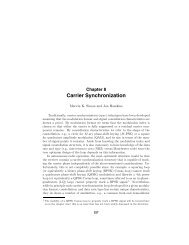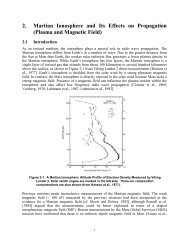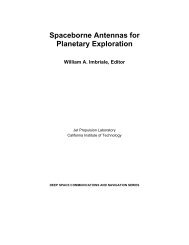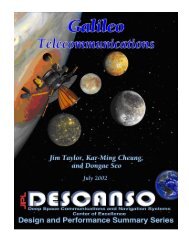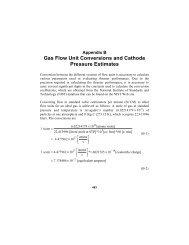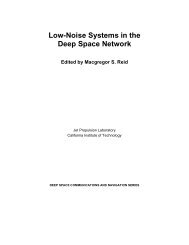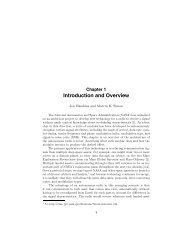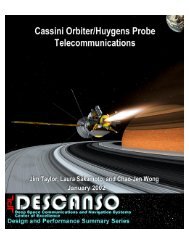Propagation Effects Handbook for Satellite Systems - DESCANSO ...
Propagation Effects Handbook for Satellite Systems - DESCANSO ...
Propagation Effects Handbook for Satellite Systems - DESCANSO ...
Create successful ePaper yourself
Turn your PDF publications into a flip-book with our unique Google optimized e-Paper software.
6.5.5.2 Gain Degradation Desiqn In<strong>for</strong>mation.<br />
6.5.5.2.1 Estimation of Domains. The effects of amplitude and<br />
angle-of-arrival fluctuations are? of course~ most prominent <strong>for</strong><br />
very long path lengths and/or very narrow beamwidths. One may<br />
estimate whether or not gain degradation need be considered in a<br />
path design if elevation angle (or equivalent path length) and<br />
antenna beamwidth are known. Figure 6.5-14 presents regimes of<br />
average gain degradation between 0.5 and 3 dB and where they must be<br />
considered as a function of elevation angle and antenna beamwidth.<br />
Realized gain, or expected gain less gain degradation, is<br />
plotted as a function of antenna beamwidth (<strong>for</strong> any frequency) or<br />
equivalent aperture diameter at 30 GHz in Figure 6.5-15. All<br />
equivalent aperture diameters are presented <strong>for</strong> an antenna aperture<br />
efficiency of 0.6. The curve representing zero path length Lt is<br />
simply the common gain approximation G = 41253/Bz where B is the half<br />
power beamwidth in &~rees. Realized gain curves <strong>for</strong> path lengths<br />
of 50 to 300 km are plotted using the model. Equivalent” earth-space<br />
path elevation angles assuming a 6 km high homogeneous atmosphere<br />
are presented in parentheses.<br />
Notice that gain degradation due to turbulence-induced<br />
fluctuation is negligible <strong>for</strong> beamwidths wider than about 0.7° <strong>for</strong><br />
all path lengths. Degradation effects then gradually increase as<br />
beamwidth narrows from 0.7° to 0.05° and at any particular beamwidth<br />
are approximately directly proportional, in dBr to path length. As<br />
beamwidth narrows beyond 0.05°, a saturation effect occurs and the<br />
degradation becomes constant <strong>for</strong> any one path length.<br />
All design figures of Section 6.5.5 represent estimates <strong>for</strong><br />
clear air effects in a temperate climate during daytime and in the<br />
warmer months of the year. If a local value of Czn is known, more<br />
accurate values of R and Sz may be obtained. If local statistics of<br />
C2n are known, statistics of R and Sz may be obtained.<br />
6-98





